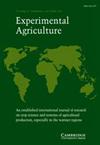High plant density increases sunlight interception and yield of direct-seeded winter canola in China
IF 1.9
4区 农林科学
Q1 Agricultural and Biological Sciences
引用次数: 0
Abstract
Summary Rationally higher population density is crucial for seeking a balance that meets lodging resistance and maximizes seed yield in mechanized direct-seeded winter canola. In this study, a split-plot experiment with two cultivars (Huayouza9 and Zhongshuang11) and eleven planting densities (12–105 plants m-2) was conducted in a two-season field experiment to evaluate the high planting density in this cropping system and improve its production efficiency. Seed yield noticeably increased in planting density up to 80 plants m-2 in Zhongshuang11 (2187 kg hm-2) and 60 plants m-2 in Huayouza9 (2943 kg hm-2). The seed yield of Huayouza9 did not differ significantly from the local target seed yield. Higher plant density curtailed the luxurious vegetative growth of individual canola plants at the density of no less than 60–80 plants m-2, and high seed yield was derived from the increased ratio of main raceme and branch seed weight in winter canola. An increase in plant densities contributed to the reinforced sunlight interception at the pod-filling stage, providing a larger canopy photosynthetic area for the rapid growth of more canola pods at higher densities (60–105 plants m-2). Lodging resistance and breaking resistance decreased sharply with the plant density increasing from 12 to 60 plants m-2 while remaining almost steady as it further increased from 60 to 105 plants m-2 for Huayouza9 and Zhongshuang11. Hence, the population density of 60 plants m-2 reached a balance between lodging resistance and maximized seed yield in mechanized direct-seeded winter canola in China.高密度提高我国冬油菜直播对阳光的截留率和产量
合理提高种群密度是实现机械化直播冬油菜抗倒伏和产量最大化平衡的关键。本研究采用花油杂9号和中双11号2个品种和11个种植密度(12 ~ 105株m-2)的分畦试验,进行了2季田间试验,以评价该种植制度的高密度种植,提高其生产效率。种植密度显著提高种子产量,中双11和花油杂9分别达到80株m-2 (2187 kg hm-2)和60株m-2 (2943 kg hm-2)。花油杂9的种子产量与当地目标种子产量差异不显著。当密度不低于60 ~ 80株m-2时,较高的植株密度会抑制单株的营养生长,而高的种子产量则来自于冬季油菜主总状花序和分枝种子重量的增加。植株密度的增加有助于增强灌荚期的阳光拦截,在较高密度(60-105株m-2)下,为更多的油菜荚果的快速生长提供了更大的冠层光合面积。花油杂9号和中双11号的抗倒伏性和抗折性随株密度从12株m-2增加到60株m-2而急剧下降,但随株密度从60株m-2增加到105株m-2而基本保持稳定。因此,60株m-2的种群密度在中国机械化直播冬季油菜的抗倒伏性和最大种子产量之间达到了平衡。
本文章由计算机程序翻译,如有差异,请以英文原文为准。
求助全文
约1分钟内获得全文
求助全文
来源期刊

Experimental Agriculture
农林科学-农艺学
CiteScore
2.50
自引率
6.20%
发文量
29
审稿时长
24 months
期刊介绍:
With a focus on the tropical and sub-tropical regions of the world, Experimental Agriculture publishes the results of original research on field, plantation and herbage crops grown for food or feed, or for industrial purposes, and on farming systems, including livestock and people. It reports experimental work designed to explain how crops respond to the environment in biological and physical terms, and on the social and economic issues that may influence the uptake of the results of research by policy makers and farmers, including the role of institutions and partnerships in delivering impact. The journal also publishes accounts and critical discussions of new quantitative and qualitative methods in agricultural and ecosystems research, and of contemporary issues arising in countries where agricultural production needs to develop rapidly. There is a regular book review section and occasional, often invited, reviews of research.
 求助内容:
求助内容: 应助结果提醒方式:
应助结果提醒方式:


